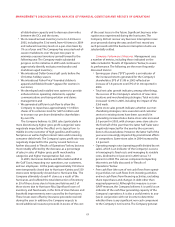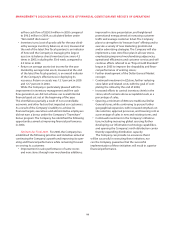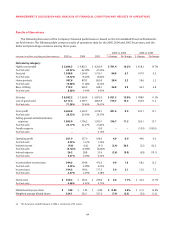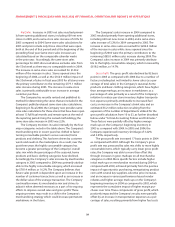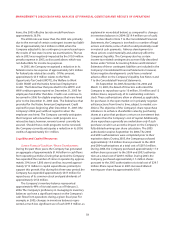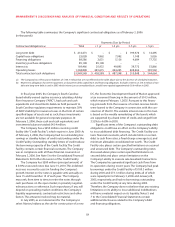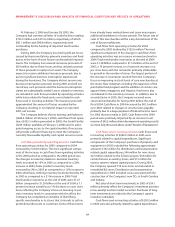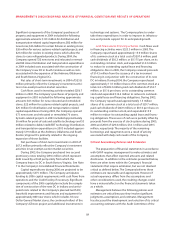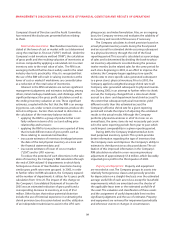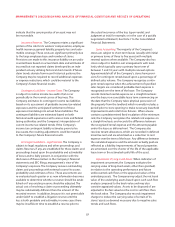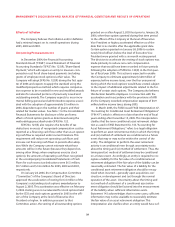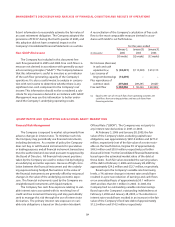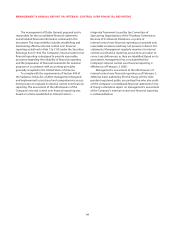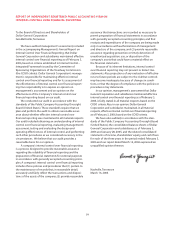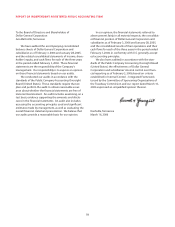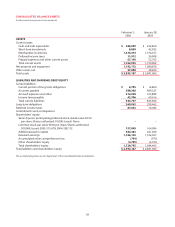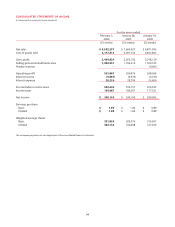Dollar General 2005 Annual Report Download - page 29
Download and view the complete annual report
Please find page 29 of the 2005 Dollar General annual report below. You can navigate through the pages in the report by either clicking on the pages listed below, or by using the keyword search tool below to find specific information within the annual report.
MANAGEMENT’S DISCUSSION AND ANALYSIS OF FINANCIAL CONDITION AND RESULTS OF OPERATIONS
25
Significant components of the Company’s purchases of
property and equipment in 2004 included the following
approximate amounts: $101 million for distribution and
transportation-related capital expenditures; $82 million for
new stores; $26 million for certain fixtures in existing stores;
$26 million for various systems-related capital projects; and
$23 million for coolers in existing stores, which allow the
stores to carry refrigerated products. During 2004, the
Company opened 722 new stores and relocated or remod-
eled 80 stores. Distribution and transportation expenditures
in 2004 included costs associated with the construction of
the Company’s new DC in South Carolina as well as costs
associated with the expansion of the Ardmore, Oklahoma
and South Boston, Virginia DCs.
Net sales of short-term investments in 2004 of $25.8
million primarily reflect the Company’s investment activi-
ties in tax-exempt auction market securities.
Cash flows used in investing activities totaled $256.7
million in 2003.The Company’s purchases of property and
equipment in 2003 included the following approximate
amounts: $63 million for new, relocated and remodeled
stores; $22 million for systems-related capital projects; and
$25 million for distribution and transportation-related
capital expenditures. During 2003, the Company opened
673 new stores and relocated or remodeled 76 stores.
Systems-related projects in 2003 included approximately
$6 million for point-of-sale and satellite technology and $3
million related to debit/credit/EBT technology. Distribution
and transportation expenditures in 2003 included approxi-
mately $19 million at the Ardmore, Oklahoma and South
Boston, Virginia DCs primarily related to the ongoing
expansion of those facilities.
Net purchases of short-term investments in 2003 of
$67.2 million primarily reflect the Company’s investment
activities in tax-exempt auction market securities.
During 2003, the Company purchased two secured
promissory notes totaling $49.6 million which represent
debt issued by a third party entity from which the
Company leases its DC in South Boston,Virginia. See Note
7 to the Company’s Consolidated Financial Statements.
Capital expenditures during 2006 are projected to be
approximately $375 million. The Company anticipates
funding its 2006 capital requirements with cash flows from
operations and the Credit Facility, if necessary. Significant
components of the 2006 capital plan include the comple-
tion of construction of the new DC in Indiana and antici-
pated costs related to the Company’s planned tenth DC;
leasehold improvements and fixtures and equipment for
approximately 800 new stores, which includes 30 new
Dollar General Market stores; the continued rollout of the
Company’s EZstore project; and additional investments in
technology and systems. The Company plans to under-
take these expenditures in order to improve its infrastruc-
ture and provide support for its anticipated growth.
Cash flows used in financing activities. Cash flows used
in financing activities were $323.3 million in 2005.The
Company repurchased approximately 15.0 million shares
of its common stock at a total cost of $297.6 million, paid
cash dividends of $56.2 million, or $0.175 per share, on its
outstanding common stock, and expended $14.3 million
to reduce its outstanding capital lease and financing
obligations. Also in 2005, the Company received proceeds
of $14.5 million from the issuance of a tax increment
financing in conjunction with the construction of its new
DC in Indiana. During 2004, the Company repurchased
approximately 11.0 million shares of its common stock at a
total cost of $209.3 million, paid cash dividends of $52.7
million, or $0.16 per share, on its outstanding common
stock and expended $16.4 million to reduce its outstand-
ing capital lease and financing obligations. During 2003,
the Company repurchased approximately 1.5 million
shares of its common stock at a total cost of $29.7 million,
paid cash dividends of $46.9 million, or $0.14 per share, on
its outstanding common stock, and expended $15.9
million to reduce its outstanding capital lease and financ-
ing obligations.These uses of cash were partially offset by
proceeds from the exercise of stock options during 2005,
2004 and 2003 of $29.4 million, $34.1 million and $49.5
million, respectively.The majority of the remaining
borrowings and repayments were a result of activity
associated with daily cash needs of the Company.
Critical Accounting Policies and Estimates
The preparation of financial statements in accordance
with GAAP requires management to make estimates and
assumptions that affect reported amounts and related
disclosures. In addition to the estimates presented below,
there are other items within the Company’s financial
statements that require estimation, but are not deemed
critical as defined below. The Company believes these
estimates are reasonable and appropriate. However, if
actual experience differs from the assumptions and
other considerations used, the resulting changes could
have a material effect on the financial statements taken
as a whole.
Management believes the following policies and
estimates are critical because they involve significant
judgments, assumptions, and estimates. Management
has discussed the development and selection of its critical
accounting estimates with the Audit Committee of the




